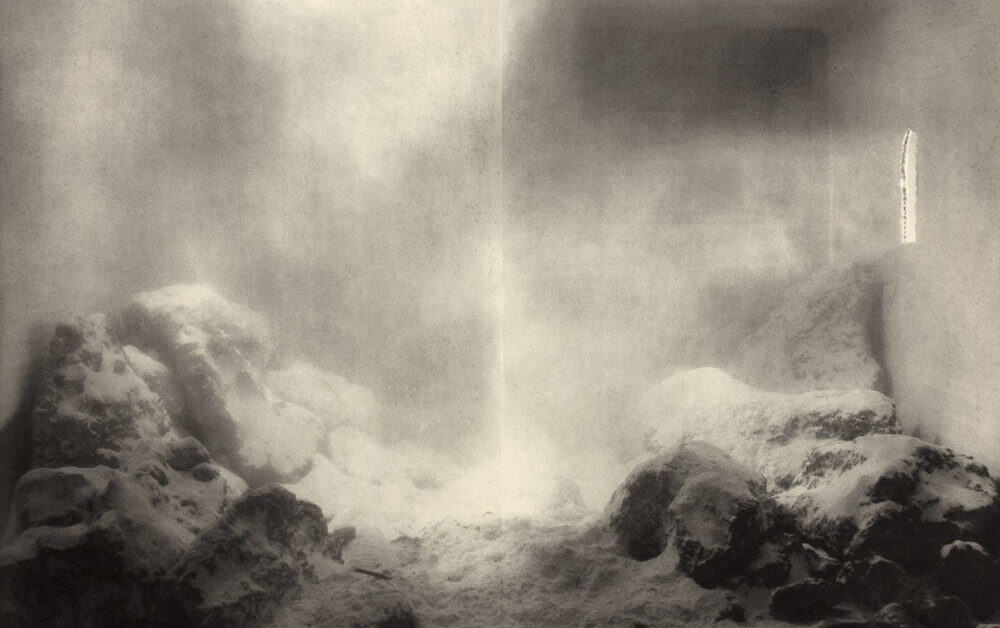A trip to FAB Gallery quite often takes you outside of your world for a brief moment. Angela Snieder’s dreamy prints do just that. Looking at them you can’t help but imagine the mysterious world that they are giving us a glimpse of. You’ll be surprised when you look closely and see just how they were created.
Your prints invoke such a mysterious feeling. Almost like we are seeing pictures of other worlds. Can you tell me a bit about the themes you are exploring in your work?
That mysterious feeling you are describing has always been important to me, not only formally (in the images I am making), but also in terms of the motivations for making the work. For me, the feeling of seeing “another world” relates strongly to the strange relationship between physical and psychological spaces – the oscillation between knowing a thing, and being surprised, compelled, or unsettled by it. I utilize mystery and ambiguity in the images to create a space that is a kind of equivalent to the elusiveness of our perception.
What got you interested in this particular exploration and style of working?
This particular exploration is new in some ways, but largely the core interests and motivations have persisted. In the beginning of my time at the University of Alberta, I felt it made most sense to create photographs by getting as close to the experience as possible. I would go out at night and shoot long film exposures of school fields in winter, trees, grass… scenes that held some of that mysterious feeling of obscurity or “in-between”. I’m not sure when it happened, but eventually I wanted a way to manipulate the subject matter more explicitly. In many ways, the diorama made a lot of sense. It’s a space that can mimic larger natural or built scenes, but that offers the artist more (or different kinds of) control. In addition to offering control over lighting and construction, the diorama is a space that can straddle the real and the unreal – which is very compelling for me.
Can you tell me a bit more about your process in composing your prints and how you create the work? You use dioramas and then photograph them?
My process for building and photographing the dioramas is above all spontaneous and intuitive. From the start, it was helpful for me to work quite quickly and with non-precious materials (mostly cardboard boxes from the alleys in my neighborhood, of which there are many!). This was crucial because it allowed me to make decisions rapidly and without worry. Using a digital camera, I had the obvious benefit of being able to look at each photo as I shot and to react to what I saw happening. At first it was a lot of trial and error, which is actually very fun when the space is so malleable and easily manipulated. This playfulness was so exciting and was something that I realized was lacking in my practice. Eventually I worked out different effects (mainly through lighting and motion) that generated feelings of natural processes but also of more ambiguous dream-like spaces. With the photographs I then made a series of photo-polymer prints, and a pair of large digital prints. In the final, darkened room of the exhibition, there are three new dioramas that project onto the walls from light-sealed boxes using the same technology as the camera obscura. The difference is that rather than seeing a naturalistic projection of the outside world into a viewing box or chamber, the constructed worlds get projected out into the space of the room.
What do you hope gallery visitors leave thinking about?
Firstly, I hope that visitors will have experienced some curiosity or surprise in the exhibition. Broadly, I hope that they will leave thinking about ways that illusion and artifice play a role in their own experiences and memories. My goal is for this reflection to encourage any kind of attentive contemplation of our physical and psychological relationship with the world.
Exhibition title: Angela Snieder: Obscura
Exhibition dates: until March 18, 2017
Venue: FAB Gallery (1-1 Fine Arts Building)
Gallery Hours: Tuesday to Friday 10 a.m. – 5 p.m.
Saturday 2 – 5 p.m.
Admission: Free

